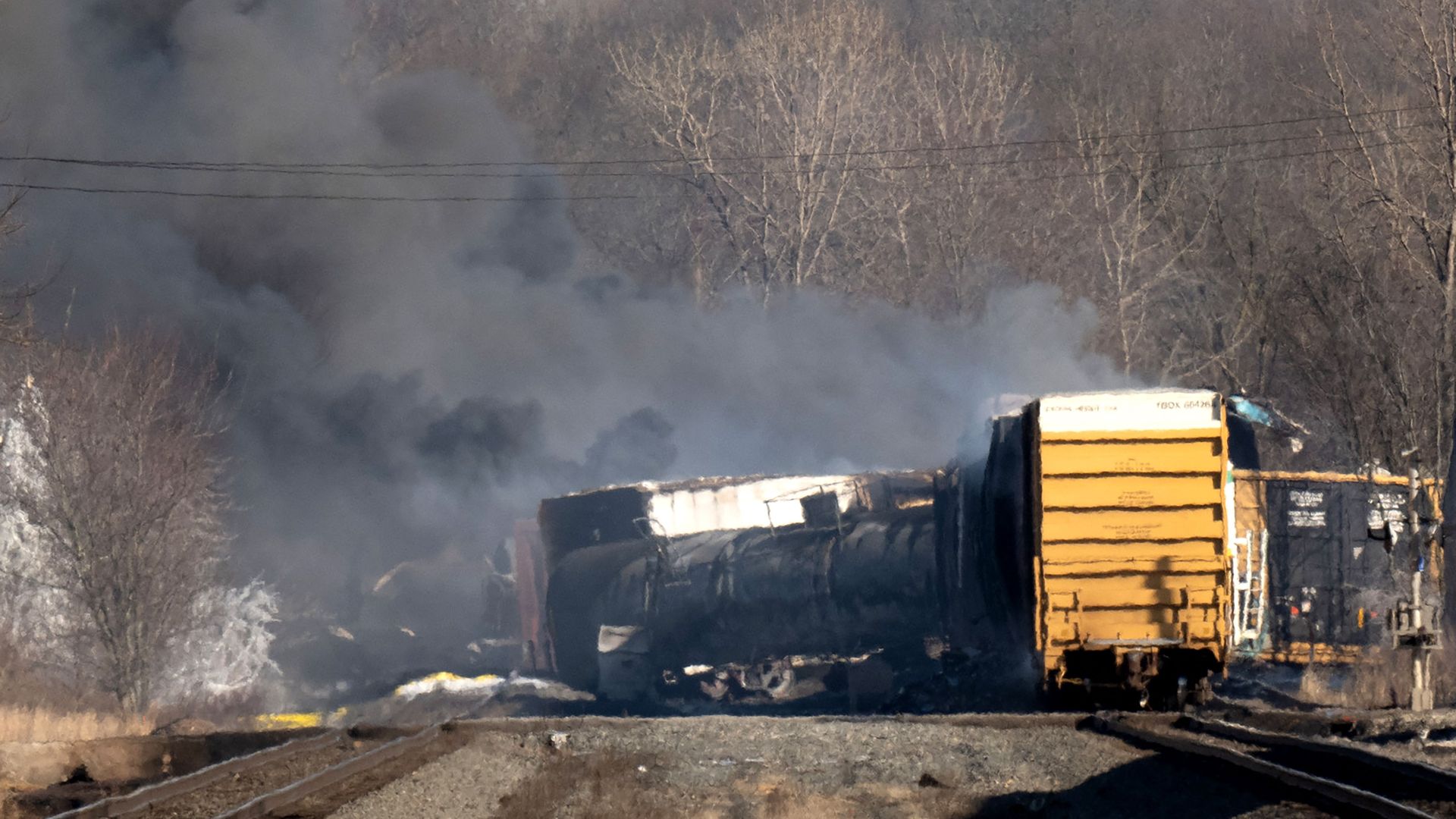Toxic Chemicals From Ohio Train Derailment: Persistence In Buildings

Table of Contents
Types of Toxic Chemicals Released and Their Persistence
The derailment released a cocktail of hazardous substances, with vinyl chloride and butyl acrylate among the most concerning. These chemicals possess properties that contribute to their persistence within building structures. Vinyl chloride, a known carcinogen, is volatile, meaning it readily evaporates into the air, but it can also absorb into porous materials like wood and drywall, slowly releasing over time. Butyl acrylate, another hazardous chemical, similarly adheres to surfaces and can off-gas for extended periods. The half-life of these chemicals – the time it takes for half the substance to degrade – can be surprisingly long, prolonging the exposure risk.
- Building Material Absorption: Porous materials like wood, drywall, carpets, insulation, and even concrete can act like sponges, absorbing these chemicals. The extent of absorption depends on the material's porosity and the chemical's concentration.
- Slow Off-Gassing: Even after the initial release, these chemicals can continue to off-gas from contaminated building materials for months or even years, leading to chronic low-level exposure.
- Environmental Factors: Temperature and humidity play a crucial role in the rate of off-gassing. Higher temperatures and humidity can accelerate the release of volatile organic compounds (VOCs) like vinyl chloride from building materials.
Pathways of Chemical Entry into Buildings
The toxic chemicals from Ohio train derailment found their way into buildings through various pathways:
-
Airborne Contaminants: The initial release created a plume of airborne contaminants that could have infiltrated buildings through open windows, doors, and ventilation systems. Wind patterns played a significant role in dispersing the chemicals over a wide area.
-
Contaminated Soil: Chemicals may have settled onto the ground, contaminating soil around buildings. Subsequent tracking of contaminated soil into buildings on shoes or equipment could introduce the chemicals indoors.
-
Contaminated Water Sources: Rainwater runoff may have carried these chemicals into water sources, potentially contaminating building water supplies if not properly treated.
-
Air Infiltration: Buildings are not airtight; air infiltration through cracks and gaps in walls and windows allows outdoor contaminants, including these chemicals, to enter.
-
HVAC Systems: Heating, ventilation, and air conditioning (HVAC) systems can inadvertently draw contaminated air from outside directly into buildings, potentially distributing chemicals throughout the structure.
-
Contaminated Water: If building water sources are contaminated, the chemicals can enter through plumbing systems, potentially leading to contamination of drinking water, and also affecting humidity levels and causing further off-gassing.
Impact on Indoor Air Quality
The persistent presence of these chemicals significantly impacts indoor air quality (IAQ). Long-term exposure, even to low levels, can have serious health consequences.
- Health Problems: Potential health problems associated with exposure include respiratory issues (coughing, shortness of breath, asthma exacerbations), headaches, nausea, dizziness, eye irritation, and other neurological symptoms. In the case of vinyl chloride, long-term exposure is linked to an increased risk of cancer.
- Detection Challenges: Detecting low-level contamination can be challenging, requiring specialized indoor air quality testing to identify and quantify the presence of these chemicals.
- Specialized IAQ Testing: Due to the complexity of identifying and quantifying these specific chemicals, specialized IAQ testing is crucial for accurate assessment and informed remediation strategies.
Remediation and Mitigation Strategies
Removing or mitigating the toxic chemicals from Ohio train derailment from buildings requires a multifaceted approach:
-
Air Purification Systems: High-efficiency particulate air (HEPA) filters and specialized air purifiers designed to remove VOCs can help reduce the concentration of airborne chemicals.
-
Specialized Cleaning: Professional cleaning using appropriate techniques and specialized cleaning agents may be necessary to remove chemicals from surfaces.
-
Building Material Replacement: In cases of severe contamination, replacement of heavily contaminated building materials may be unavoidable.
-
Effectiveness of Remediation: The effectiveness of different remediation techniques varies depending on the type and extent of contamination. Professional assessment is essential to determine the most appropriate approach.
-
Cost Implications: Remediation costs can be substantial, ranging from relatively inexpensive air purification to extensive building renovations.
-
Professional Assessment: It is critical to engage qualified professionals for assessment and remediation of these toxic chemicals to ensure proper handling and effective cleanup.
Long-Term Health Concerns and Monitoring
The long-term health implications of exposure to these persistent chemicals are a significant concern. Ongoing monitoring and health assessments are crucial.
- Epidemiological Studies: Longitudinal epidemiological studies are needed to track the health effects of exposure and establish a clear causal link between exposure and specific health outcomes.
- Causality Challenges: Determining a direct causal link between low-level, long-term exposure to these chemicals and specific health problems can be scientifically challenging.
- Long-Term Health Surveillance: Long-term health surveillance of affected populations is essential to monitor health trends and identify any emerging health issues.
Conclusion:
The persistence of toxic chemicals from Ohio train derailment in buildings poses a significant and ongoing threat to public health. The potential for long-term exposure to these hazardous substances necessitates proactive assessment, remediation, and ongoing monitoring. Understanding the pathways of entry, the impact on indoor air quality, and the available remediation strategies is crucial for protecting residents and mitigating long-term health risks. If you suspect contamination in your building from the Ohio train derailment's toxic chemicals, seek professional assessment and remediation immediately. Contact your local health department or environmental agencies for resources and guidance. Protecting your health and the health of your community requires vigilance and proactive measures to address the lingering effects of this environmental disaster. Don't hesitate to take action to ensure the safety of your home and family against the lasting impact of these dangerous toxic chemicals.

Featured Posts
-
 Red Sox 2025 Espns Controversial Season Prediction
Apr 28, 2025
Red Sox 2025 Espns Controversial Season Prediction
Apr 28, 2025 -
 Austin Teens Find Inspiration In Bubba Wallace Ahead Of Cota
Apr 28, 2025
Austin Teens Find Inspiration In Bubba Wallace Ahead Of Cota
Apr 28, 2025 -
 Yankees Max Fried Dominant Debut In 12 3 Rout Of Pirates
Apr 28, 2025
Yankees Max Fried Dominant Debut In 12 3 Rout Of Pirates
Apr 28, 2025 -
 Mets Send Nez To Syracuse Megill In Starting Rotation
Apr 28, 2025
Mets Send Nez To Syracuse Megill In Starting Rotation
Apr 28, 2025 -
 Espn Promotes Richard Jefferson Finals Assignment Still Pending
Apr 28, 2025
Espn Promotes Richard Jefferson Finals Assignment Still Pending
Apr 28, 2025
